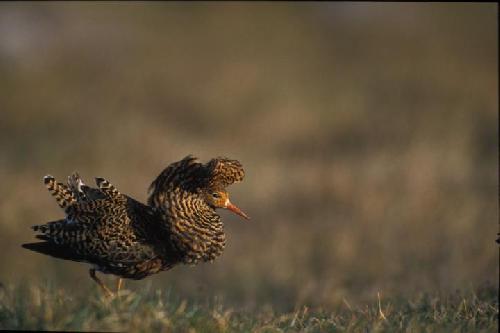The ruff is a Eurasian shorebird that has a spectacular lekking behaviour where highly ornamented males compete for females. Now two groups report that males with alternative reproductive strategies carry a chromosomal rearrangement that has been maintained as a balanced genetic polymorphism for about 4 million years.
The two studies, one led by scientists at Uppsala university, are published today in Nature Genetics.
Three different types of ruff males occur at the leks of this species. 'Independent' males show colourful ruffs and head tufts and fight vigorously for territories. 'Satellite' males are slightly smaller than Independents, do not defend territories and have white ruffs and head tufts. 'Faeder' males mimic females by their small size and lack of ornamental feathers, they do not defend territory.
 Independent male ruff at lek with colourful ruff and head tuft. Credit: Ola Jennersten
Independent male ruff at lek with colourful ruff and head tuft. Credit: Ola Jennersten
The Independent and Satellite males show a remarkable interaction where the Satellite males allow Independent males to dominate them on the leks.
Both Independents and Satellites benefit from the interaction because it increases their mating success by attracting females that are ready to mate, explains Fredrik Widemo who did his PhD on ruff lekking behaviour. Faeder males also have a chance to mate with females when other males are occupied with male-male interactions, continues Fredrik.
Previous studies have indicated that these remarkable differences between male morphs are under strict genetic control and are determined by a single genetic region. How can such complex differences in behaviour, size and plumage have a simple genetic basis? To shed light on this enigma the researchers have sequenced the entire genome from Independent, Satellite and Faeder males.
We discovered that both Satellite and Faeder males carry a 'supergene' which is not a gene with superpower but a cluster of about 90 genes kept together by a chromosomal inversion which means that there is no genetic exchange between the three different morphs, says Sangeet Lamichhaney, one of the PhD students involved in the study.
The group reports that the sequence difference between the chromosome variants is as large as 1.4 percent that is higher than the average sequence difference between human and chimpanzee chromosomes. The scientists estimate that the chromosome inversion happened about 4 million years ago.
The Satellite and Faeder male morphs are the result of an evolutionary process over million of years and involve many genetic changes among the 90 genes in this 'supergene', explains Leif Andersson, who led the study.
The 'supergene' contains five genes that have a role in the metabolism of steroid hormones.
It is particularly interesting that we see an enrichment of genetic changes in the vicinity of a gene, HSD17B2, that determines an enzyme that converts active testosterone to a more inactive form, continues Leif Andersson. Independents have a significantly higher level of testosterone than Satellite and Faeder males and we think this is the reason that in turn leads to an altered behaviour.
There are many examples of associations between behaviour and pigmentation in animals but the underlying causal relationships have rarely been revealed. The present study now provides insights into why there is such a strong association between altered behaviour and white colour in Satellite males.
The simple answer is that the 'supergene' contains both genes like HSD17B2 affecting the metabolism of sex hormones and the MC1R gene controlling pigmentation, explains Sangeet Lamichhaney.
Why has this fascinating difference in male reproductive strategies evolved in the ruff?
Fighting over territories and females is both energetically costly and risky. This created an opportunity for the evolution of alternative male mating strategies in which males spend less energy on fighting, explains Fredrik Widemo.
We think that this evolutionary process started with the occurrence of the inversion about 4 million years ago and that the inversion in itself altered the regulation of one or more genes affecting the metabolism of sex hormones and this created a primitive alternative male morph, which has been further improved step by step by the accumulation of many genetic changes, ends Leif Andersson.
source: Uppsala University